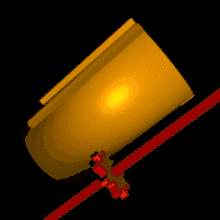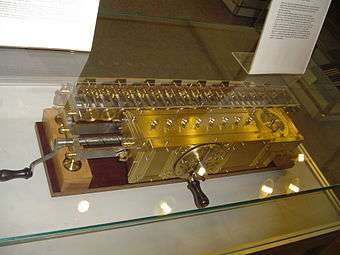Leibniz wheel
A Leibniz wheel or stepped drum is a cylinder with a set of teeth of incremental lengths which, when coupled to a counting wheel, can be used in the calculating engine of a class of mechanical calculators. Invented by Leibniz in 1673, it was used for three centuries until the advent of the electronic calculator in the mid-1970s.


Leibniz built a machine called the stepped reckoner based on the design of the stepped drum in 1694.[1] It was made famous by Thomas de Colmar when he used it, a century and a half later, in his Arithmometer, the first mass-produced calculating machine.[2] It was also used in the Curta calculator, a very popular portable calculator introduced in the second part of the 20th century.
Concept
By coupling a Leibniz wheel with a counting wheel free to move up and down its length, the counting wheel can mesh with any number of teeth.
The animation on the side shows a nine-tooth Leibniz wheel coupled to a red counting wheel. It is set to mesh with three teeth at each rotation and therefore would add or subtract 3 from the counter at each rotation.
The computing engine of an Arithmometer has a set of linked Leibniz wheels coupled to a crank handle. Each turn of the crank handle rotates all the Leibniz wheels by one full turn. The input sliders move counting wheels up and down the Leibniz wheels which are themselves linked by a carry mechanism.
From the late nineteenth century on, Leibniz stepped drums in purely mechanical calculators were partially supplanted by pinwheels which are similar in function but with a more compact design; stepped drums remained the primary technology for electromechanical calculators until the development of purely electronic calculators.
Machines built using this principle












Notes
- Ifrah, p. 125 (2001)
- Chase, p.204 (1980)
- Marguin, p.65 (1994)
- Marguin, p.83 (1994)
- Picture of Hahn's Calculator IBM Collection of mechanical calculators
- Marguin, p.84-86 (1994)
- Door E. Felt, p.15-16 (1916)
- Pictures of the Edmonson calculator www.rechenmaschinen-illustrated.com
Sources
- Chase, George C (July 1980). History of Mechanical Computing Machinery. Volume 2, Number 3. IEEE Annals of the History of Computing.
- Ifrah, Georges (2001). The Universal History of Computing. John Wiley & Sons, Inc. ISBN 0-471-39671-0.
- de Brabandere, Luc (1995). Calculus (in French). Paris: Mardaga. pp. 114–125. ISBN 978-2-87009-591-1.
- Marguin, Jean (1994). Histoire des instruments et machines à calculer, trois siècles de mécanique pensante 1642-1942 (in French). Hermann. ISBN 978-2-7056-6166-3.
External links
- Arithmometre.org - Main page - The first commercially successful machine that used Leibniz wheels
- ami19.org - A great site for patents and articles on 19th century mechanical calculators
- Rechenmaschinen-Illustrated - A large display of mechanical calculators